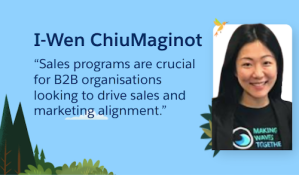I-Wen Chiumaginot, Senior Manager of Global Sales Programs Field Support, explains the importance of sales programs and how they can drive B2B marketing and sales alignment.
I left my comfort zone when I moved from marketing to sales programs nearly four years ago. Not only was I saying goodbye to a company I had been working at for a decade, but I was also leaving a function I was passionate about. One of my top reasons for making that move was the opportunity to contribute to marketing and sales alignment in a sales program role.
After working in various marketing roles ranging from planning to digital marketing, one thing is evident: marketing and sales collaboration are critical to any B2B marketing campaign’s success.
But what exactly are sales programs? And how can they help align sales and marketing pipeline generation activities?
What are sales programs?
Sales programs — not being a standard function in most corporations yet — are often misunderstood. In fact, a quick Internet search will display plenty of results for sales training programs, but hardly anything that correctly defines what a sales program actually is.
Thankfully I found an article that gets it right, but it’s over 5 years old. Search LinkedIn for sales programs and there’s even more diversity. You’ll see roles offered in everything from sales and strategy operations to marketing.
Two of my previous Sales Program Manager colleagues wrote insightful articles explaining the value that sales program managers provide: one that makes an interesting comparison to conquering tunnel vision in Formula 1 and another that highlights Sales Programs’ importance in creating a winning company culture.
My elevator pitch describing the role would be: sales program managers are ‘Chief Pipeline Officers’ to sales leaders. Working in close partnership and alignment with marketing, strategy, and enablement, they analyse business performance and run pipeline programs to close specific business gaps.
3 ways Sales Programs Help Sales and Marketing Alignment
- As a previous Salesforce blog article points out, to truly perfect Sales and Marketing alignment we need metrics that matter to both organisations, and this is still one of the biggest challenges in aligning sales and marketing efforts today.
B2B Marketing typically focuses on the top of the funnel – brand awareness, content views, and number of leads generated, but Sales might not see the value in executing a Marketing campaign if it does not result in opportunities generated and deals closed. Sales program managers can help connect the two ends of the funnel by using sales program KPIs that are relevant to both, such as lead to opportunity conversion.
- The content journey is often broken. Figures from SiriusDecisions reveal that 65% of content created by marketing is never used by sales teams, and a Forrester report shows that 90% of B2B sellers don’t use marketing content because it lacks relevance, is outdated, or is too difficult to customise.
Sales programs help maximise content ROI by leveraging relevant marketing resources into Sales’ pipeline generation efforts so that Sales can save the searching time and focus on doing what they do best — sell.
- Successful alignment cannot be achieved without regular communication and collaboration, Sales Programs Managers play a key role in involving sales supporting teams including marketing in the quarterly sales programs planning process and monthly business reviews with sales leaders, so that cross-functional stakeholders can discuss and agree on business priorities in terms of products, solutions or industries, as well as how respective efforts will be measured.
Sales program managers can add value to B2B marketing
B2B marketing teams must make good, data-driven decisions, so having the right metrics from sales in place — and the right Sales Programs to deliver on them — is crucial.
For sales program managers, driving operational excellence through consistency, fine-tuning of planning, execution, and a culture of teamwork is a great place to begin a journey towards better alignment.
If you’ve enjoyed this article, get our bi-weekly newsletter for the latest business insights from the Salesforce EU Blog.
























